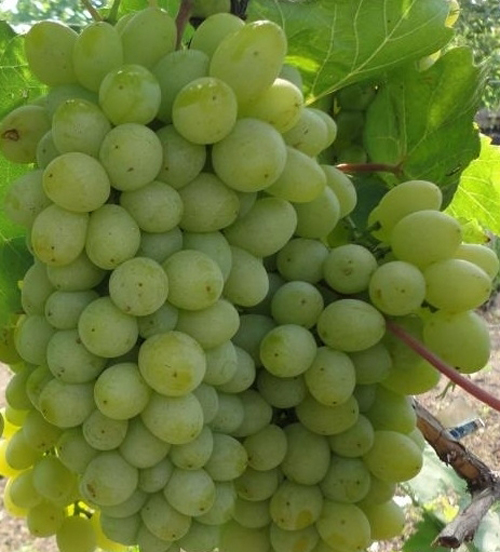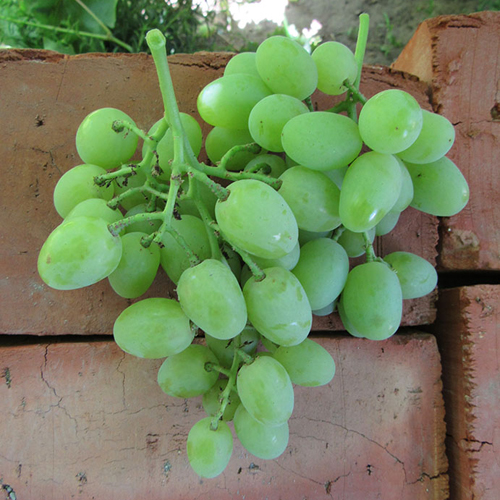Harold grape variety
Harold is a promising hybrid form of light-colored table grapes bred by the Novocherkassk Scientific Research Institute of Viticulture and Winemaking. ME AND. Potapenko. Over the years since its inception, it has been tested on the sites of many amateurs, earning widespread love and respect due to the many virtues that it possesses. However, he did not wait for official recognition and inclusion in the State Register of Breeding Achievements, still remaining in the list of temporarily permitted varieties.
The birth of the novelty occurred as a result of complex hybridization, during which first such famous varieties as Delight and Arcadia, and then the resulting form was in turn fertilized with Muscat pollen. From the resulting offspring, a grape seedling with a number of positive qualities was isolated, which laid the foundation for a new variety.

The most important distinguishing characteristic that makes Harold very popular with winegrowers is the very early ripening period of the crop. In addition, its asset can be a good yield, high sugar accumulation and wonderful taste of berries, which, moreover, have a bright nutmeg aroma. The frost resistance of the vine is somewhat increased, as is the resistance of the form to diseases and pests. The disadvantages of some picky growers include the average size of bunches and berries, but this is a matter of taste, because many do not like, on the contrary, overly giant fruits. The only objective flaw in its characteristics can be called the tendency to overload, which requires increased attention when rationing the yield.
Agrobiological characteristics
Grape bushes are distinguished by moderate growth, although on powerful high-stemmed formations, as well as vigorous rootstocks, it can be "dispersed" to a large size. The crown of a young shoot is green with a barely noticeable bronze tint, slightly wrinkled, covered with sparse cobweb pubescence. The shoot axis is yellowish-green, without signs of anthocyanin pigmentation. A typical leaf is large, somewhat elongated, five-lobed and strongly dissected. The surface of the leaf blade of the variety is reticulate-wrinkled, dark green, with light veins that have a pink tint at the base. The leaf profile is flat or slightly funnel-shaped. The upper side notches are deep, mostly open, with parallel sides and a slightly tapered bottom, but open lyre-shaped and closed ones with a narrow elliptical lumen can be found. Lower notches of shallower depth, also parallel, or V-shaped. The petiolate notch is vaulted with a rounded or pointed bottom. The petioles are comparable in length to the main vein of the leaf, colored greenish-red. The teeth along the edge of the plate are large, triangular, with a medium-wide base, convex edges, and sharp apices. The flowers are bisexual, and therefore the plants are perfectly pollinated on their own, without showing any serious flaws in the form of peas or shedding of the ovary. The annual growth ripens well, the shoots of the grapes acquire a brown color.

Harold's ripe bunches are above medium in size, cylindrical, of moderate density. Their average weight is 400-500 grams. The combs are herbaceous, light green in color, sometimes with reddish stripes. The stems of the berries are short. The grapes are not too large, oval with a pointed end, 24-26 mm long, 20-22 mm in diameter. The berries are painted in a pleasant amber-yellow color, the surface is covered with a light waxy bloom of a light shade. Each of them weighs 5-8 grams, and in relation to each other they are very aligned, which makes the bunches very elegant and neat. The pulp of the berries is tender, juicy and fleshy, and has a pleasant taste.A distinct nutmeg is noticeable in the aroma and aftertaste, which is a very valuable trait for many winegrowers. Sugar accumulation, like many descendants of the famous Delight, the variety is high - 19-20 g / 100 cc. Titratable acidity - 4-5 g / cubic dm. The sugar-acid ratio in berry juice is quite harmonious, with some predominance of sweetness when fully ripe. The skin of the grapes is firm and moderately strong, but edible. Some, very sophisticated gourmets, note a certain excess density of the skin compared to the tenderness of the pulp. The bones are present, but, due to their small size, they do not have a negative effect on the taste. In general, the tasting characteristics of the grapes are quite high.
The harvested crop is used mainly for fresh consumption, but it is quite suitable for making tasty and aromatic juices, compotes, and preserves. It is in demand among buyers due to its attractive appearance and the presence of nutmeg in the taste. For a fairly high interest in the market, it is also appreciated by farmers, for whom Harold's very early ripening period is an important point, which makes it possible to sell grapes during a period of high prices. In addition, an important characteristic of the variety for commercial use is the high transportability of the bunches, which allows them to be transported over long distances without deteriorating the presentation. Its keeping quality is also good, especially if optimal conditions are created in the storage room.

The main competitive advantage of our hero, as already mentioned, is the very early ripening of the crop. Less than 100 days pass from the beginning of budding to the onset of the removable maturity of the bunches, and therefore, in the southern viticultural regions, harvesting begins already from the end of July. But, of course, such an early ripe hybrid can be cultivated not only in the south. Due to the modest sum of active temperatures required by plants for growth and full-fledged fruiting - 2100-2200 ° C, it is possible to grow it in open ground up to the latitude of the Moscow region, Nizhny Novgorod and Yekaterinburg. Not the least role in this is played by the frost resistance of the form, increased to -24 ° C. Even if it will not be enough in the most frost-prone regions for non-covering cultivation, even there the warming of our hero for the winter can be significantly simplified compared to more pampered grape varieties.
The potential yield of this variety is at a very high level, and often even exceeds the physical capabilities of plants, which leads to overloads and natural negative consequences in the form of a sharp deterioration in the taste of fruits, a decrease in the growth energy of shoots and problems with their ripening. Such a predisposition requires the grower to make efforts to normalize the load of bushes with shoots and crops. In figures, Harold's productivity indicators are as follows: the proportion of fruitful shoots - 75-85%; fruiting coefficient - 1.1-1.3; fertility coefficient - 1.5-, 1.6. The average yield, which well-developed adult bushes can withstand without signs of overload, is about 15 kg of grapes.
The dense skin of the berries allows you to leave the bunches hanging on the vine for a long time without the risk of spoilage, damage by wasps or cracking from rain. However, overripe harvest in this variety is fraught with problems of a different kind - a decrease in the intensity of the nutmeg aroma and liquefaction of the pulp, which, of course, does not contribute to an improvement in the tasting characteristics. And although during full ripening the berries continue to accumulate sugar, this advantage does not compensate for the negative processes that occur in parallel.
Agrotechnical features
In the course of many years of cultivation on amateur and farm plots, Harold showed himself to be a rather unpretentious and plastic variety, capable of successfully growing in a variety of climatic conditions and different levels of agricultural technology. A not too experienced winegrower can cope with it, the main thing is to take into account the key points that will prevent serious mistakes.
Particular attention should be paid to the choice of a planting site for grapes, especially in the northern regions, where the hybrid is spreading more and more due to early ripening. Here, for the variety, the most warm areas should be selected on the hills or southern slopes, where the microclimate for the culture is more favorable than in open flat areas. In garden plots, a similar effect can be achieved by placing bushes in a wall culture, protected from northern winds with the help of various buildings. In the rich, warm south, these requirements are not so relevant, but even there one should not break up a vineyard on the slopes of cold exposures, as well as in the lowlands of hollows or gullies.
The method of reproduction of grapes depends on the conditions in which our hero will grow, and first of all - on the presence of phylloxera in the soil. If we are talking about traditional wine-growing regions, where a malicious pest is found almost everywhere, then planting is strongly recommended to be carried out with seedlings on phylloxera-resistant rootstocks. For most amateurs, whose areas are located north of the zone of continuous soil contamination by root aphids, it will not be difficult to root Harold's cuttings on their own, and thereby get their own rooted planting material.
The need to shelter the bushes of this variety for the winter is determined by the minimum winter temperatures typical for a particular region. It is preferable to cultivate plants on a high trunk, however, this is possible within the climatic zone, where the thermometer does not fall below the critical value for a hybrid of -24 ° C. In more severe conditions, it will be necessary to use stumpless squat formations, which allow you to annually remove the vine from the trellis without damage in the fall, and return it back in the spring.
Due consideration must be given to pruning the grapes, which, along with the debris of the shoots and the thinning of the inflorescences, is the main activity in regulating the load of Harold's bushes. This procedure is carried out rather shortly due to the good fertility of the lower eyes, in general, leaving up to 30-40 buds on the plant. Those shoots that have developed from them, which turn out to be sterile, break off, and on the fruitful ones they leave only one, in rare cases, two brushes.
The resistance of the variety to the main fungal diseases is at the level of 3-3.5 points. To combat them, it will be enough to carry out 2-3 preventive spraying during the period of the greatest harmfulness of pathogens at the beginning of the growing season, and then carry out careful phytosanitary control, and already pointwise respond to single outbreaks of pathogenic microorganisms in grapes.








